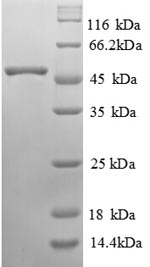Alpha-galactosidase A (GLA) is a crucial enzyme involved in lysosomal function and lipid metabolism. GLA is responsible for hydrolyzing the terminal alpha-galactosyl moiety from glycoconjugates [1]. Mutations in the GLA gene lead to Fabry disease, a rare X-linked disorder characterized by deficient activity of GLA, resulting in the intracellular accumulation of enzyme substrates inside lysosomes [2]. This accumulation, particularly of globotriaosylceramide-3 (Gb3), is specific to Fabry disease with classical mutations and is associated with small fiber neuropathy [3].
Fabry disease can present with symptoms mimicking hypertrophic cardiomyopathy, emphasizing the importance of genetic screening to establish a diagnosis, especially in women [4]. The absence or deficiency of GLA enzyme due to mutations results in multiorgan glycosphingolipid accumulations, leading to various clinical manifestations [5]. Chaperone therapy has been explored in Fabry disease to address the underlying enzyme deficiency [6].
The cardiovascular phenotype in Fabry disease has been linked to residual GLA activity, which may influence disease progression and the manifestation of clinical signs [7]. Dysregulation of immune response mediators and pain-related ion channels has been associated with pain-like behavior in Fabry disease, highlighting the complex interplay between GLA mutations and symptomatology [8]. Additionally, cornea verticillata has been reported in classical Fabry disease cases, further underlining the diverse systemic manifestations of GLA mutations.
References:
[1] S. Wu, L. Xiang, J. Geng, M. Zhang, N. Xie, & X. Su, "Hydroxychloroquine-induced renal phospholipidosis resembling fabry disease in undifferentiated connective tissue disease: a case report", World Journal of Clinical Cases, vol. 7, no. 24, p. 4377-4383, 2019. https://doi.org/10.12998/wjcc.v7.i24.4377
[2] R. Liguori, A. Incensi, S. Pasqua, R. Mignani, E. Fileccia, M. Santostefanoet al., "Skin globotriaosylceramide 3 deposits are specific to fabry disease with classical mutations and associated with small fibre neuropathy", Plos One, vol. 12, no. 7, p. e0180581, 2017. https://doi.org/10.1371/journal.pone.0180581
[3] O. Havndrup, M. Christiansen, B. Stoevring, M. Jensen, J. Hoffman-Bang, P. Andersenet al., "Fabry disease mimicking hypertrophic cardiomyopathy: genetic screening needed for establishing the diagnosis in women", European Journal of Heart Failure, vol. 12, no. 6, p. 535-540, 2010. https://doi.org/10.1093/eurjhf/hfq073
[4] S. Gaballa, A. AlJaf, J. Lindsay, K. Patel, & K. Hlaing, "Rare etiology of renal failure in a 25-year-old caucasian man: fabry disease with a novel mutation of gla gene", Cureus, 2020. https://doi.org/10.7759/cureus.9136
[5] F. Weidemann, A. Jovanović, K. Herrmann, & İ. Vardarli, "Chaperone therapy in fabry disease", International Journal of Molecular Sciences, vol. 23, no. 3, p. 1887, 2022. https://doi.org/10.3390/ijms23031887
[6] D. Sorriento and G. Iaccarino, "The cardiovascular phenotype in fabry disease: new findings in the research field", International Journal of Molecular Sciences, vol. 22, no. 3, p. 1331, 2021. https://doi.org/10.3390/ijms22031331
[7] M. Spitzel, E. Wagner, M. Breyer, D. Henniger, M. Bayin, L. Hofmannet al., "Dysregulation of immune response mediators and pain-related ion channels is associated with pain-like behavior in the gla ko mouse model of fabry disease", Cells, vol. 11, no. 11, p. 1730, 2022. https://doi.org/10.3390/cells11111730
[8] H. Hewavitharana, E. Jasinge, H. Abeysekera, & J. Wanigasinghe, "Cornea verticillata in classical fabry disease, first from sri lanka: a case report", BMC Pediatrics, vol. 20, no. 1, 2020. https://doi.org/10.1186/s12887-020-02237-z






